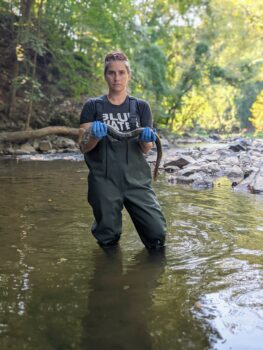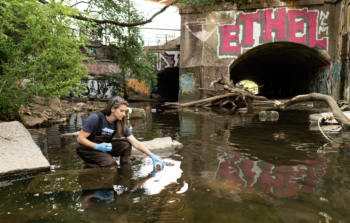Who Is Waterkeeper: Alice Volpitta, Baltimore Harbor Waterkeeper
By: Thomas Hynes

Alice Volpitta can trace her love for water back to when she grew up in Maryland crabbing and fishing with her dad on the tributaries of the Chesapeake Bay. After college, she worked for the state’s Department of Natural Resources doing water quality monitoring. At the time, she felt that the data was being shelved and would never see the light of day. (Though, happily, she would later realize that all that work would inform the Chesapeake Bay model’s total maximum daily loads.) Nevertheless, Alice wanted to do more. So in 2014, she joined Blue Water Baltimore, the parent organization for Baltimore Harbor Waterkeeper.
“For years and years, I always said, ‘No, I don’t want to be a Waterkeeper. You have to be crazy to be a Waterkeeper.’ And then I became a Waterkeeper,” said Alice. “Because I realized that all I want to do is sue polluters and speak up for something that is so right. A really cool thing about waterway protection is that it’s not about right wing or left wing, it’s really a unifier. It’s really not controversial. And I feel very stable doing what I know is best for the river. It feels really clear to me what I need to be doing.”
 Baltimore’s waterways are very polluted, but they are also teeming with life. As such, Alice faces a lot of the same challenges as other Waterkeeper groups in urban settings. That can include stormwater runoff, legacy industrial contaminants, and even trash. Sewer overflows are also a major concern. Though, interestingly, one of the biggest joys Alice gets in this work is teaching people about sewer overflows. She never knew about sewage overflows until she came to Blue Water Baltimore, even after working for the state.
Baltimore’s waterways are very polluted, but they are also teeming with life. As such, Alice faces a lot of the same challenges as other Waterkeeper groups in urban settings. That can include stormwater runoff, legacy industrial contaminants, and even trash. Sewer overflows are also a major concern. Though, interestingly, one of the biggest joys Alice gets in this work is teaching people about sewer overflows. She never knew about sewage overflows until she came to Blue Water Baltimore, even after working for the state.
“It’s just not something you’re taught about in school around here,” says Alice. “And so when I first started learning the mechanics of plumbing in Baltimore, and how our whole way of life is dependent on these underground pipes, and how it can go really wrong really fast, and sharing that information with people and seeing those lightbulbs go off has been really satisfying. It’s so obvious but it’s so difficult to wrap your head around it.”
She’s also realizing how much of a threat climate change is. Ten years ago they were wondering what the nexus was between their work and climate change. Today, that connection has become more obvious. It’s leading to more frequent storms which is exasperating stormwater runoffs and sewage overflows.
“One of the issues we are facing specifically in Baltimore is that a lot of communities feel really disenfranchised and really undervalued by the city itself,” says Alice. “Because there is a disparity between where our department of public works is putting money in the ground to fix those issues.”
A few years back, Alice worked with Johns Hopkins University School of Public Health to study complaints of sewage backing up into people’s homes. It’s effectively turning people’s homes into temporary cesspools and storage tanks for the excess sewage. In Baltimore, neighborhoods with a higher percentage of black residents are more likely to experience a sewage backup. Historic lack of investment in upgrading those specific pipes is most likely to blame. It’s one of the many clear environmental justice issues that Alice and Baltimore Harbor Waterkeeper is combatting.

“The city has a consent decree for sewage overflows in the city, so every time it happens, the city has to pay stipulated penalties. But if that overflow is caught by someone’s basement, it’s not technically flowing into waters of the United States, so it doesn’t incur stipulated penalties the way a normal overflow would,” says Alice. “This can create a perverse incentive for the city to find solutions that direct that sewage back into people’s homes, and that’s one of the reasons we continue to watchdog implementation of the consent decree. It’s a really terrible situation.”
On the bright side, Alice has enjoyed a number of successes in defending her watershed. Recently, she helped negotiate a consent decree with the Maryland Department of the Environment and Baltimore City to resolve violations at the state’s two largest treatment plants for nearly $5 million in penalties, which makes it the largest clean water enforcement action in Maryland in the last 25 years.
The story begins back at the inception of Blue Water Baltimore in 2010, when they began collecting water quality monitoring samples. There are currently about 50 monitoring stations throughout Baltimore, one of which is strategically placed on top of the effluent pipe of the Patapsco Wastewater Treatment Plant, which discharges tens of millions of gallons of supposedly clean water per day.
For years, that was one of their cleanest stations. However, in April of 2021, they started to notice really high levels of bacteria. Two weeks later, they checked again and got another really high reading. It set off a red flag for Alice who reported it to the Maryland Department of the Environment. Alice’s findings led to an inspection which found gross operation and maintenance deficiencies. The finer details of that inspection are almost too disgusting to share. Suffice to say they found the same conditions at the city’s other wastewater treatment facility. Both facilities were found to be far exceeding the limits in their permits. Systemic deficiencies and staffing shortages at both plants caused a cascade of failures that led to partially untreated sewage being discharged into the Patapsco and Back Rivers. The amount of pollution that was released from these two facilities cannot be overstated. The two wastewater treatment plants discharged twice as much dead zone-causing nitrogen pollution in 2021 as they did in 2019. That excess alone – more than 2 million pounds – was equal to nearly every other WWTP in Maryland combined.
So Alice brought a federal Clean Water Act enforcement case in December of 2021. Shortly thereafter, the Maryland Department of the Environment brought a state enforcement action as well. After two years of back and forth, they negotiated a consent decree that is made up of a big list of projects that the city has to complete, including replacing and repairing machinery at both facilities. It also involves proper staffing, greater transparency and accountability measures, new signage to protect public health, and third-party oversight.
“The thing I’m most proud of about this is that $1.9 million is going to stay in Baltimore. It’s going to be administered as a new grant through a nonprofit called the Chesapeake Bay Trust,” says Alice. “So this is going to be a dedicated fund that local groups can apply to put that money right back into water quality programs for communities that have been directly harmed.”
Baltimore Harbor Waterkeeper is also in active litigation against the Fleischmann’s Vinegar Company, one of the largest vinegar companies in the world. One of their buildings is right on the banks of the Jones Falls in Baltimore, a stream which flows into the Inner Harbor and Patapsco River. It also happens to be crumbling and in need of repairs, which led it to discharge vinegar directly into the stream. In September of 2021, a massive fishkill was documented downstream. It kicked off a federal case, which also inspired the state of Maryland to take action.
Though the case is still ongoing, given the track record of Alice and the team at Blue Water Baltimore, it’s safe to say a good outcome for water will occur.